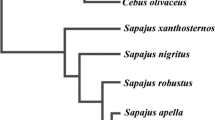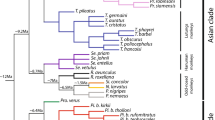Abstract
Dental variation in the Chinese golden monkey (Rhinopithecus roxellana) is here evaluated by univariate, bivariate, and multivariate analyses. Allometric analyses indicate that canines and P3s are positively, but other dimensions negatively scaled to mandible and maxilla, and to body size. With the exception of the mesiodistal dimensions of I1 and M3, and the buccolingual dimension of P4, mandibular dental variables show similar scaling relative to body size. Analysis of residuals shows that males have significantly larger canine, P3 and buccolingual dimensions of the postcanine teeth (M2 and M3) than females. A significant difference in shape between the sexes is found in the buccolingual dimension of the upper teeth, but not in the mandible. Unlike the situation in some other species, female golden monkeys do not exhibit relatively larger postcanine teeth than males. In fact, the reverse is true, expecially for M2s and M3s. The fact that most of the dental variables show low negative allometry to body size might be related a cold environment that has led to the development of larger body size with reduced energy loss. When the raw data are examined by Discriminant Function Analysis the sexes are clearly distinguishable.
Similar content being viewed by others
References
Atchley, W. R. 1993. Genetic and developmental aspects of variability in the mammalian mandible. In:The Skull Development, Vol. 1,Hanken,J.;Hall,B. K. (eds.), The Univ. of Chicago Press, Chicago & London, pp. 207–247.
Atchley, W. R.;Plummer, A. A.;Riska, B. 1985. Genetic divergence in mandible form in relation to molecular divergence in inbred mouse strains.Genetics, 111: 577–579.
Beherents, R. G. 1985.Growth in the Aging Craniofacial Skeleton: Craniofacial Growth Series (Monograph 17), Univ. of Michigan, Ann Arbor.
Bleisch, W.;Cheng, A. S.;Ren, X. D.;Xie, J. H. 1993. Preliminary results from a field study of wild Guizhou snub-nosed monkeys (Rhinopithecus brelichi).Folia Primatol., 60: 72–82.
Chen, F. G.;Min, Z. L.;Luo, S. Y.;Xie, W. Z. 1989. Relationship between dentition erupting and age of the golden monkey. In:Progress in the Studies of Golden Monkey,Chen,F. G. (ed.), Northwestern Univ., Xian, China, pp. 44–50.
Cochard, L. R. 1985. Ontogenetic allometry of the skull and dentition of the rhesus monkey (Macaca mulatta). In:Size and Scaling in Primate Biology,Jungers,W. L. (ed.), Plenum Press, New York & London, pp. 231–255.
Cochard, L. R. 1987. Postcanine tooth size in female primates.Amer. J. Phys. Anthropol.,74: 47–54.
Comuzzie, A. G.;Steel, D. G. 1989. Enlarged occlusal surface on first molars due to severe attrition and hypercemention: examples from prehistoric coastal populations of Taxas.Amer. J. Phys. Anthropol., 78: 9–15.
Corruccini, R. S. 1972. Allometry correlation in taximetrics.Sys. Zool., 21: 375–383.
Creighton, C. K. 1980. Static allometry of mammalian teeth and the correlation of tooth size and body size in contemporary mammals.J. Zool. Lond., 191: 435–443.
Eaglen, R. H. 1984. Incisor size and diet revisited: the view from a platyrrhine perspective.Amer. J. Phys. Anthropol., 64: 263–275.
Gingerich, P. B.;Smith, B. H. 1985. Allometric scaling in the dentition of primates and insectivores. In:Size and Scaling in Primate Biology,Jungers,W. L. (ed.), Plenum Press, New York & London, pp. 257–272.
Gingerich, P. B.;Smith, B. H.;Rosenberg, K. 1982. Allometric scaling in the dentition of primates and prediction of body weight from tooth size in fossils.Amer. J. Phys. Anthropol., 58: 81–100.
Gordon, K. D. 1982. A study of microwear on chimpanzee molars: implication for dental microwear analysis.Amer. J. Phys. Anthropol., 59: 195–215.
Gould, S. J. 1975a. On the scaling of tooth size in mammals.Amer. Zool., 15: 351–362.
Gould, S. J. 1975b. Allometry in primates with emphasis on scaling and the evolution of the brain.Contribution to Primatology, 5: 244–292.
Hall, B. K.;Hörstadius, S. 1988.The Neural Crest. Oxford Univ. Press, London.
Harvey, O.;Kavanagh, M.;Clutton-Brock, T. 1978. Sexual dimorphism in primate teeth.J. Zool. Lond., 186: 475–485.
Horder, T. H. 1981. On not throwing the baby out with the bath water. In:Evolution Today,Scudder,G. G. E.;Reveal,J. L. (eds.), Carnegie Mellon Univ., Pittsburgh, pp. 163–180.
Hu, J. C.;Den, Q. X.;Yu, Z. W. 1989. A study of the ecological biology of the golden monkey. In:Progress in the Studies of Golden Monkey,Chen,F. G. (ed.), Northwestern Univ., Xian, China, pp. 208–215.
Jablonski, N. G. 1992. Dental agenesis as evidence of possible genetic isolation in the colobine monkey,Rhinopithecus roxellana.Primates, 33: 371–376.
Jablonski, N. G. 1993. Quaternary environments and the evolution of primates in East Asia, with notes on two new specimens of fossil Cercopithecidae from China.Folia Primatol.,60: 118–132.
Jablonski, N. G. (ed.) 1998. The evolution of the doucs and snub-nosed monkeys and the questions of the phyletic unity of the odd-nosed colobines. In:The Natural History of the Doucs and Snub-nosed Monkeys: Recent Advances in Human Biology, Vol. 4, World Scientific Publ., Singapore, pp. 13–52.
Jablonski, N. G.;Pan, R. L. 1995. Sexual dimorphism in the snub-nosed langurs (Colobinae: Rhinopithecus).Amer. J. Phys. Anthropol., 96: 251–272.
Jablonski, N. G.;Pan, R. L.;Chaplin, G. 1998. Mandibular morphology of the doucs and snub-nosed monkeys in relation to diet. In.The Natural History of the Doucs and Snub-nosed Monkeys: Recent Advances in Human Biology, Vol. 4,Jablonski,N. G. (ed.), World Scientific Publ., Singapore, pp. 105–128.
Jablonski, N. G.;Peng, Y. Z. 1993. The phylogenetic relationships and classification of the doucs and snub-nosed langurs of China and Vietnam.Folia Primatol., 60; 36–55.
Jungers, W. L. 1984. Aspects of size and scaling in primate biology with special reference to the locomotor skeleton.Yrbk. Phys. Anthropol., 27: 73–97.
Jungers, W. L.;Grine, F. E. 1986. Dental trends in the australopithecine canines: the allometry of mandibular molar dimensions. In:Major Topics in Primate and Human Evolution,Wood,B.;Martin,L.;Anderson,P. (eds.), Cambridge Univ. Press, Cambridge, pp. 203–219.
Kanazawa, E.;Sekikawa, M.;Ozaki, T. 1988. Morphological relationship between teeth and mandible in colobus monkeys.J. Oral. Sci. (Nihon Univ.), 14: 189–201.
Kay, R. F. 1975. Allometry and early hominids.Science, 189: 63.
Kieser, J. A.;Groeneveld, H. T. 1987. Static intraspecific maxillofacial allometry in the Chacma baboon.Folia Primatol., 48: 151–163.
Kieser, J. A.;Groeneveld, H. T. 1988. Patterns of metric variability in the dentition ofPapio ursinus Amer. J. Primatol., 14: 141–151.
Kieser, J. A.;Groeneveld, H. T. 1990. Static intraspecific allometry of the dentition in Otolemur crassicaudatus.Zool. J. Linnean. Soc., 98: 295–306.
Kieser, J. A.;Groeneveld, H. T. 1991. Allometric perspective on primate postcanine tooth size.Folia Primatol., 56: 33–38.
Larsen, C. S.;Shavit, K. 1988. Dental evidence for change in lifeway quality: a case study from Spanish, Florida.Amer. J. Phys. Anthropol., 75: 236. (abstract)
Lavell, R. F. 1978. Metric analysis of primate tooth form. In:Development, Function and Evolution of Teeth,Butler,P. A.;Joysey,K. A. (eds.), Academic Press, London, New York & San Francisco, pp. 229–247.
Leutenegger, W. 1976. Metric variability in anterior of African colobus.Amer. J. Phys. Anthropol., 45: 45–52.
Leutenegger, W.;Kelly, J. T. 1977. Relationship of sexual dimorphism in canine size and body size to social, behavioral and ecological correlates in anthropoid primates.Primates, 18: 117–136.
Li, G. H.;Shi, C. D. 1989. Food of the golden monkey. In:Progress in the Studies of Golden Monkey,Chen,F. G. (ed.), Northwestern Univ., Xian, China, pp. 222–224.
Liu, S. F. 1989. A preliminary investigation of the golden monkey in Quing-Ling Mountains. In:Progress in the Studies of Golden Monkey,Chen,F. G. (ed.), Northwestern Univ., Xia, China, pp. 201–206.
Lucas, P. W.;Corlett, R. T.;Luke, D. A. 1986. Sexual dimorphism of tooth size in Anthropoids. In:Sexual Dimorphism in Living and Fossil Primates,Pickford,M.,Chiarelli,B.;Editrice,B. (eds.) Giugno, Firenze, pp. 23–39.
Mayr, E. 1963.Animal Species and Evolution. Belknap Press of Harvard Univ. Press, Cambridge, Massachusetts.
Meiklejohon, C.;Schentag, C. T. 1988. Portuguese Mesolithic series and their implication.Amer. J. Phys. Anthropol., 75: 249. (abstract)
Napier, J. P.;Napier, P. H. 1967.A Handbook of Living Primates. Academic Press, London & New York.
Pan, R. L. 1998. A craniofacial study of the genusMacaca, with special reference to the stump-tailed macaques,M. arctoides andM. thibetana: a functional approach. Ph.D. thesis, The Univ. of Western Australia, Australia.
Pan, R. L.;Jablonski, N. G. 1993. Scaling of limb proportions and limb bone diameters in three species of Chinese snub-nosed langurs (GenusRhinopithecus).Folia Primatol., 60: 56–62.
Pan, R. L.;Oxnard, C. E. 2000. Craniodental variation of macaques (Macaca): size, function and phylogeny.Zool. Res., 21: 308–322.
Pan, R. L.;Peng, Y. Z.;Ye, Z. Z. 1993. Sexual dimorphism of the shoulder girdle and upper limb in golden monkey (Rhinopithecus).Primate Report, 35: 31–47.
Pan, R. L.;Peng, Y. Z.;Ye, Z. Z.;Yu, F. H.;Wang, H. 1992. Comparison of dental dimensions betweenRhinopithecus bieti andR. roxellana.Folia Primatol., 59: 221–227.
Pan, W. S.;Yong, Y. 1989. The biology of the golden monkey. In:Progress in the Studies of Golden Monkey,Chen,F. G. (ed.), Northwestern Univ., Xian, China,, pp. 222–224.
Pan, Y. R.;Jablonski, N. G. 1987. The age and geographical distribution of fossil cercopithecids in China.Human Evol., 2: 59–69.
Pickford, M. 1986a. Sexual dimorphism in Proconsul. In:Sexual Dimorphism in Living and Fossil Primates, Pickford, M.;Chiarelli, B.;Editrice, B. (eds.), Giugno, Firenze, pp. 133–170.
Pickford, M. 1986b. The orignis of body size dimorphism in primates. In:Sexual Dimorphism in Living and Fossil Primates,Pickford,M.;Chiarelli,B.;Editrice,B. (eds.), Giugno, Firenze, pp. 77–91.
Pickford, M. 1986c. Sexual differences in higher primates: a summary statement. In:Sexual Dimorphism in Living and Fossil Primates,Pickford,M.;Chiarelli,B.;Editrice,B. (eds.), Giugno, Firenze pp. 191–199.
Pilbeam, D.;Gould, S. J. 1974. Size and scaling in human evolution.Science, 186: 892–901.
Pirie, P. L. 1978. Allometric scaling in the postcanine dentition with reference to primate diets.Primates, 19: 583–591.
Quan, G. X.;Xie, J. H. 1989. Notes onRhinopithecus roxellanae brelichi Thomas. In:Progress in the Studies of Golden Monkey,Chen,F. G. (ed.), Northwestern Univ., Xian, China, pp. 26–29.
Rose, C.;Reiss, J. O. 1993. Metamorphisis and the vertebrate skull: ontogenetic patterns and developmental mechanisms. In:The Skull Development, Vol. 1,Henken,J.;Hall,B. K. (eds.), The Univ. of Chicago Press, Chicago & London, pp. 289–346.
Scapino, R. P. 1972. Adaptive radiation of mammalian jaws. In:Morphology of the Maxillo-Mandibular Apparatus,Schumacher,C. H. (ed.), Thieme, Leipzig, pp. 33–39.
Shi, D. C.;Li, G. H.;Fu, T. L. 1982. Preliminary ecological research in golden monkeys.Zool. Res., 3: 105–110.
Smit-Vis, J. H.;Griffioen, F. M. M. 1987. Growth control of neurocranial height of the rat skull.Anatomische Anzeiger, 163: 401–406.
Smith, M. D. 1988. Periodontal disease in prehistoric Tennessee Valley Indians.Amer. J. Phys. Anthropol., 75: 272.
Smith, R. J. 1981a. On the definition of variables in studies of primate dental allometry.Amer. J. Phys. Anthropol., 55: 323–329.
Smith, R. J. 1981b Interspecific scaling of maxillary canine size and shape in female primates: relationships to social structural and diet.J. Human Evol., 10: 165–173
Steegman, A. T., Jr.;Platner, W. S. 1968. Experimental cold modification of craniofacial morphology.Amer. J. Phys. Anthropol., 28: 17–30.
Su, Y. J.;Ren, R. M.;Yan, K. H.;Li, H. J.;Zhou, Y.;Shu, Q. Z.;Hu, Z. L.;Hu, Y. F. 1998. Preliminary survey of the home range and ranging behavior of golden monkeys [Rhinopithecus (Rhinopithecus) roxellana] in Shennongjia National Natural Reserve, Hubie, China. In:The Natural History of the Doucs and Snub-nosed Monkeys: Recent Advances in Human Biology, Vol. 4,Jablonski,N. G. (ed.), World Scientific Publ., Singapore, pp. 255–268.
Walker, A. C. 1984. Mechanism of honing of the baboon canine.Amer. J. Phys. Anthropol., 65: 47–60.
Weave, M. E.;Ingram, D. L. 1969. Morphological changes in swine associated with environmental temperature.Ecology, 50: 710–713.
Wolpoff, M. H. 1985. Tooth size-body size scaling in a human population theory and practice of an allometric analysis. In.Size and Scaling in Primate Biology,Jungers,W. L. (ed.), Plenum Press, New York & London, pp. 273–318.
Wood, B. A. 1979. Analysis of tooth and body size relationship in five primate taxa.Folia Primatol., 31: 187–211.
Ye, Z. Z.;Peng, Y. Z.;Liu, R. L.;Zhang, Y. P. 1987.The Gross Anatomy of the Golden Monkeys. Yunnan People's Publ. House, Kunming, China.
Zhen, Q. X.;Fu, J. S.;Wen, Y. Z. 1981. Ecology and distribution of the golden monkey (Rhinopithecus).Acta Nanchong Teachers' College (Sichuan, China), 3: 75–85.
Author information
Authors and Affiliations
About this article
Cite this article
Pan, R., Oxnard, C. Metrical dental analysis on golden monkey (Rhinopithecus roxellana). Primates 42, 75–89 (2001). https://doi.org/10.1007/BF02640691
Received:
Accepted:
Issue Date:
DOI: https://doi.org/10.1007/BF02640691




